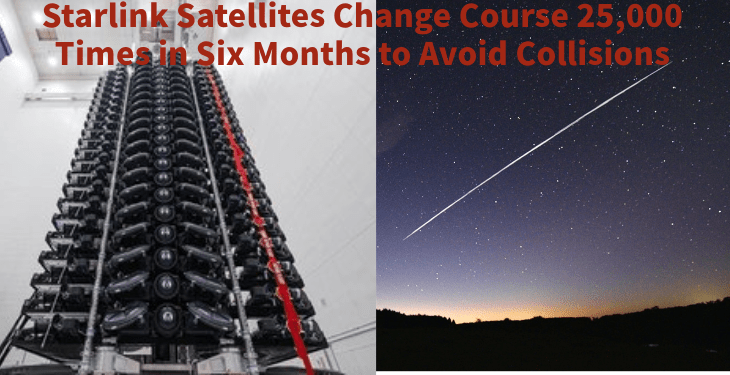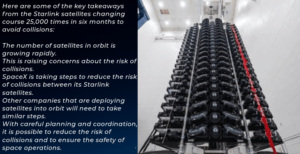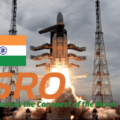Starlink Satellites Make 25,000 Course Corrections to Avoid Collisions

SpaceX’s Starlink constellation of satellites has been in the news lately for its potential to provide high-speed internet access to people all over the world. However, the constellation has also been criticized for the number of times its satellites have had to change course to avoid collisions.
In the first six months of 2023, Starlink satellites changed course more than 25,000 times to avoid collisions. This is a significant number, and it raises concerns about the safety of the constellation.
There are a number of reasons why Starlink satellites have had to change course so often. One reason is that the number of satellites in orbit is increasing. There are now more than 3,000 active satellites in orbit, and that number is expected to grow in the coming years. As the number of satellites increases, the risk of collisions also increases.
Another reason why Starlink satellites have had to change course so often is that the constellation is designed to be very flexible. The satellites can be moved around in orbit to avoid collisions, and they can also be moved to different locations to provide better coverage. This flexibility is a good thing, but it also means that the satellites are more likely to change course.
SpaceX is taking steps to mitigate the risk of collisions. The company uses a variety of techniques to track other objects in orbit and predict potential collisions. If a collision is predicted, the satellites can be moved out of the way.
SpaceX is also working on developing a new technology called “collision avoidance assist.” This technology would allow satellites to communicate with each other and coordinate their movements to avoid collisions.
The number of Starlink satellites is expected to grow in the coming years. As the constellation grows, the risk of collisions will also grow. However, SpaceX is taking steps to mitigate the risk of collisions, and the company is confident that the constellation can operate safely.
Here are some of the key takeaways from the Starlink satellites changing course 25,000 times in six months to avoid collisions:
- The number of satellites in orbit is increasing, which is raising concerns about the risk of collisions.
- SpaceX’s Starlink constellation has made more than 25,000 collision avoidance maneuvers in the past six months.
- The company’s satellites are equipped with sensors that can detect other objects in orbit.
- The risk of collisions remains a concern as the number of satellites in orbit is expected to continue to grow.
Here are some of the key takeaways from the Starlink satellites changing course 25,000 times in six months to avoid collisions:
- The number of satellites in orbit is growing rapidly.
- This is raising concerns about the risk of collisions.
- SpaceX is taking steps to reduce the risk of collisions between its Starlink satellites.
- Other companies that are deploying satellites into orbit will need to take similar steps.
- With careful planning and coordination, it is possible to reduce the risk of collisions and ensure the safety of space operations.
Here are some of the key takeaways from the Starlink satellites changing course 25,000 times in six months to avoid collisions:
- The number of satellites in orbit is increasing, which is increasing the risk of collisions.
- Starlink satellites are designed to be flexible, which means that they are more likely to change course to avoid collisions.
- SpaceX is taking steps to mitigate the risk of collisions, including using collision avoidance assist technology.
- The number of Starlink satellites is expected to grow in the coming years, which will increase the risk of collisions.
Here are some of the key takeaways from the Starlink satellites changing course 25,000 times in six months to avoid collisions:
- The number of satellites in orbit is increasing, which is raising concerns about the risk of collisions.
- SpaceX’s Starlink constellation has made more than 25,000 collision avoidance maneuvers in the past six months.
- The company’s satellites are equipped with sensors that can detect other objects in orbit.
- The risk of collisions remains a concern as the number of satellites in orbit is expected to continue to grow.
What can be done to mitigate the risk of collisions between satellites?
- Satellite operators can use sensors to detect other objects in orbit and make course corrections to avoid collisions.
- Satellite operators can also coordinate with each other to avoid collisions.
- New technologies are being developed to track and predict the movement of objects in orbit, which could help mitigate the risk of collisions.
- There needs to be better coordination between different satellite operators.
- New technologies, such as collision avoidance assistance, need to be developed.
- The public needs to be aware of the risks of collisions between satellites.
The risk of collisions between satellites is a serious problem. However, there are a number of things that can be done to mitigate the risk. By taking these steps, we can help keep our space environment safe.







